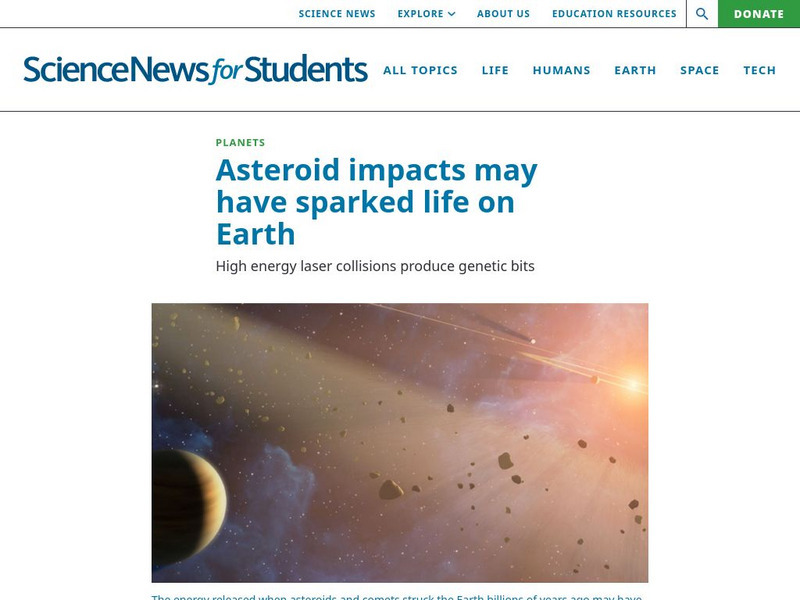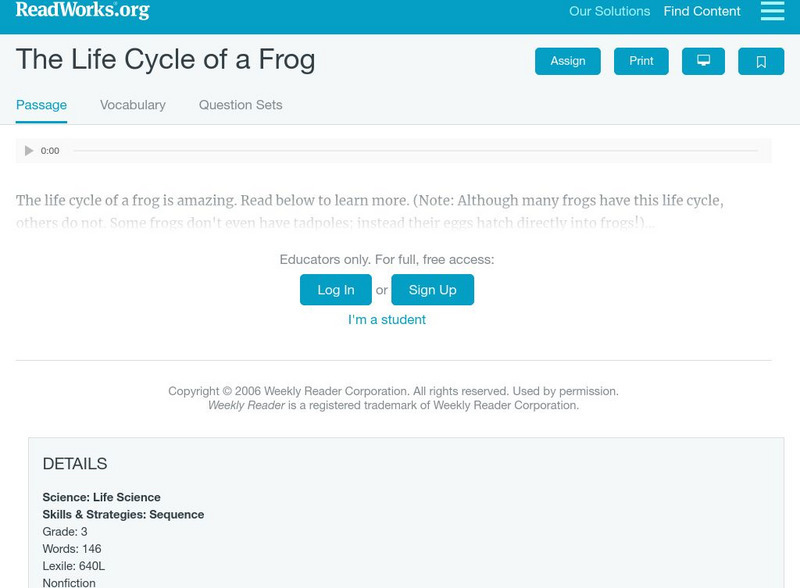Hi, what do you want to do?
Curated OER
Breaking News English: Laboratory-Created Eggs and Sperm
In this English worksheet, learners read "Laboratory-Created Eggs and Sperm," and then respond to 47 fill in the blank, 7 short answer, 20 matching, and 8 true or false questions about the selection.
Curated OER
The View
Students explore the structure and purpose of Op-Ed pieces in the newspaper. They then write Op-Eds from the perspectives of United States presidents on important issues of their day.
Curated OER
War Expectations
Students determine what they think Americans currently expect regarding warfare and its cost in human lives and examine the sources of these expectations.
Curated OER
Meeting our Basic Needs
Students brainstorm the basic needs of the community and create a chart. In this volunteerism lesson, students recognize people in the community who have given charity in the community. Students read biographies of these charitable...
Curated OER
Breaking News English: Designer Babies Row in Britain
In this English worksheet, students read "Designer Babies Row in Britain," and then respond to 47 fill in the blank, 7 short answer, 20 matching, and 8 true or false questions about the selection.
Society for Science and the Public
Science News for Students: Ocean Animals Have Mushroomed in Size
Article reports on the increasing size of ocean animals over the millenia. Includes a list of key vocabulary.
Science Buddies
Science Buddies: Career Profile: Animal Breeder
Do you think a career in animal breeding might be interesting? This article in Science Buddies gives a clear assessment of what you might expect in that career. Find out what education you need, what the work environment is like, and...
Society for Science and the Public
Science News for Students: Asteroid Impacts May Have Sparked Life
Article reports on a new study that claims that the energy released from asteroid collisions may have sparked life on Earth. Includes a list of key vocabulary.
Khan Academy
Khan Academy: Biology: Intro to Biology: What Is Life?
This article explores exactly what is considered alive but reviewing over the characteristics of life.
Open Curriculum
Open Curriculum: Early Life
The aim of this article relates the nature of science to our current understanding of the origin of life and describe the formation of the atoms which build the Earth and its life.
Read Works
Read Works: Life Finds a Way
[Free Registration/Login Required] An informational text about life in the deepest parts of the ocean. A question sheet is available to help students build skills in reading comprehension.
Read Works
Read Works: Marine Biology
[Free Registration/Login Required] A literary text about a boy named Frank who grew up loving the ocean and has dreams of becoming a marine biologist. A question sheet is available to help students build skills in reading comprehension.
Read Works
Read Works: The Life Cycle of a Frog
[Free Registration/Login Required] An informational text about the steps in a frog's life cycle. A question sheet is available to help students build skills in reading comprehension.
Khan Academy
Khan Academy: Biology: Chemistry of Life: Matter, Elements, and Atoms
Did you know matter is made up of atoms? In this article learn about the smallest unit of matter called the atom.
Khan Academy
Khan Academy: Biology: Chemistry of Life: Atomic Number,atomic Mass,and Isotopes
Learn the fundamental properties of atoms in this article. Understand the definition of atomic number, atomic mass, and isotopes. [6 min, 50 sec]
Khan Academy
Khan Academy: Biology: Chemistry of Life: Chemical Bonds
Review over covalent, hydrogen, and ionic bonding in this article. Learn how molecules are held together by chemical bonds.
Khan Academy
Khan Academy: Biology: Chemistry of Life: Chemical Reactions
An article discussing how chemical reactions make and break bonds between atoms.
University of California
University of California Museum of Paleontology: Understanding Science: Dna
Find out how the human side of science played a role in the significant discovery of the molecule of life, DNA.
Society for Science and the Public
Science News for Students: Motion in the Ocean
This article reports on recent research that explains why corals are in nearly constant motion. Includes a brief video. [0:16]
Read Works
Read Works: Will Human Life on Earth Come to an End?
[Free Registration/Login Required] An informational text about science fiction authors and their predictions about space travel. A question sheet is available to help students build skills in reading comprehension.
Society for Science and the Public
Science News for Students: Like Poison for Phosphorus
Discusses a research study undertaken at Mono Lake in California, known for its extreme salty conditions, which supports unusual life forms. Scientists found that a bacterium could survive using arsenic instead of phosphorus,...
Society for Science and the Public
Science News for Students: Sleepless at Sea
Can you go for a month without sleeping? Most mammals can't, but scientists have found some marine mammals that do. Find out why some orcas and dolphins don't sleep for weeks at a time.
Story Behind the Science
Story Behind the Science: Search for Life's Origins [Pdf]
Article describing research done by scientists in their quest to understand the origins of life. Questions are posed throughout about the nature of scientific research.
University of Minnesota
University of Minnesota: Ships: Science & Religion of Michael Faraday
Here's a whole different look at Faraday. His religion, Sandemanian, greatly influenced both his life and his science. This article looks deeply at that aspect of his life.



























![Story Behind the Science: Search for Life's Origins [Pdf] Article Story Behind the Science: Search for Life's Origins [Pdf] Article](https://static.lp.lexp.cloud/images/attachment_defaults/resource/large/FPO-knovation.png)